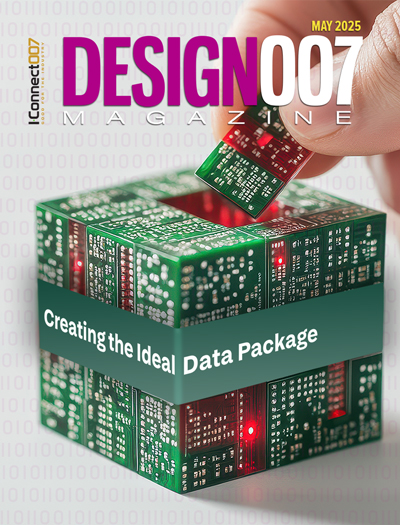-

- News
- Books
Featured Books
- design007 Magazine
Latest Issues
Current Issue
Creating the Ideal Data Package
Why is it so difficult to create the ideal data package? Many of these simple errors can be alleviated by paying attention to detail—and knowing what issues to look out for. So, this month, our experts weigh in on the best practices for creating the ideal design data package for your design.

Designing Through the Noise
Our experts discuss the constantly evolving world of RF design, including the many tradeoffs, material considerations, and design tips and techniques that designers and design engineers need to know to succeed in this high-frequency realm.

Learning to Speak ‘Fab’
Our expert contributors clear up many of the miscommunication problems between PCB designers and their fab and assembly stakeholders. As you will see, a little extra planning early in the design cycle can go a long way toward maintaining open lines of communication with the fab and assembly folks.
- Articles
- Columns
Search Console
- Links
- Media kit
||| MENU - design007 Magazine
Book Excerpt: Thermal Management With Insulated Metal Substrates, Part 2
June 16, 2020 | I-Connect007 Editorial TeamEstimated reading time: 2 minutes
The following is an excerpt from the second half of Chapter 1 of The Printed Circuit Designer's Guide to... Thermal Management With Insulated Metal Substrates written by Ventec International Group’s Didier Mauve and Ian Mayoh. In this free eBook, the authors provide PCB designers with the essential information required to understand the thermal, electrical, and mechanical characteristics of insulated metal substrate laminates.
The thermal conductivity of a substance k is an intrinsic property that indicates its ability to conduct heat. Some relevant examples are illustrated in Table 1.1.
Heat can be dissipated from QFN components by mounting them on thermal pads connected to internal copper planes by thermal via holes. Problems of solder wicking into the holes and causing voided joints can be avoided by filling the holes with thermally conductive resin and plating them over with copper, or by completely filling the holes with electroplated copper. Solid copper “coins” can be bonded into recesses milled into the PCB to conduct heat away from individual power devices. All of these techniques can be effective, but they usually involve additional materials and processing, and a significant cost premium.
Many power electronics and under the hood automotive devices are built on direct-bonded copper (DBC) substrates because of their strong thermal conductivity. They are based on a ceramic tile (commonly alumina) with a sheet of copper bonded to one or both sides by a high-temperature oxidation process. The top copper layer can be formed prior to firing or chemically etched using PCB technology to form an electrical circuit, while the bottom copper layer is usually kept plain so that it can be soldered to a heat spreader by soldering the bottom copper layer to it. Beryllia, silicon nitride, and aluminum nitride are more effective heat conductors than alumina, but cost considerably more. Further, thick-film technology can be used in some high-reliability applications. Thick-film technology offers a higher degree of design freedom than direct-bonded copper, but it may also be less cost-efficient.
LED manufacturers have adopted packaging technologies from the power electronics field with the result that they can now offer efficient thermal coupling from the semiconductor to the primary interconnecting substrate of the package. However, it remains that the only path for heat out of the LED is via the bottom of the LED package to the PCB, which must not present a thermal barrier. For high-power LEDs, the thermal conductivity of an FR-4 PCB is insufficient to enable effective heat transfer, and insulated metal substrate materials offer a better solution. These materials generally consist of a thermally-conductive dielectric layer heavily loaded with ceramic-type fillers that are sandwiched between copper foil and an aluminum or copper plate. The dielectric may be unreinforced or woven-glass reinforced.
To download this free eBook, published by I-Connect007, click here.
To view the entire I-Connect007 eBook library, click here.
Suggested Items
Indium’s Karthik Vijay to Present on Dual Alloy Solder Paste Systems at SMTA’s Electronics in Harsh Environments Conference
05/06/2025 | Indium CorporationIndium Corporation Technical Manager, Europe, Africa, and the Middle East Karthik Vijay will deliver a technical presentation on dual alloy solder paste systems at SMTA’s Electronics in Harsh Environments Conference, May 20-22 in Amsterdam, Netherlands.
SolderKing Achieves the Prestigious King’s Award for Enterprise in International Trade
05/06/2025 | SolderKingSolderKing Assembly Materials Ltd, a leading British manufacturer of high-performance soldering materials and consumables, has been honoured with a King’s Award for Enterprise, one of the UK’s most respected business honours.
Knocking Down the Bone Pile: Gold Mitigation for Class 2 Electronics
05/07/2025 | Nash Bell -- Column: Knocking Down the Bone PileIn electronic assemblies, the integrity of connections between components is paramount for ensuring reliability and performance. Gold embrittlement and dissolution are two critical phenomena that can compromise this integrity. Gold embrittlement occurs when gold diffuses into solder joints or alloys, resulting in mechanical brittleness and an increased susceptibility to cracking. Conversely, gold dissolution involves the melting away of gold into solder or metal matrices, potentially altering the electrical and mechanical properties of the joint.
'Chill Out' with TopLine’s President Martin Hart to Discuss Cold Electronics at SPWG 2025
05/02/2025 | TopLineBraided Solder Columns can withstand the rigors of deep space cold and cryogenic environments, and represent a robust new solution to challenges facing next generation large packages in electronics assembly.
BEST Inc. Reports Record Demand for EZReball BGA Reballing Process
05/01/2025 | BEST Inc.BEST Inc., a leader in electronic component services, is pleased to announce they are experiencing record demand for their EZReball™ BGA reballing process which greatly simplifies the reballing of ball grid array (BGA) and chip scale package (CSP) devices.


